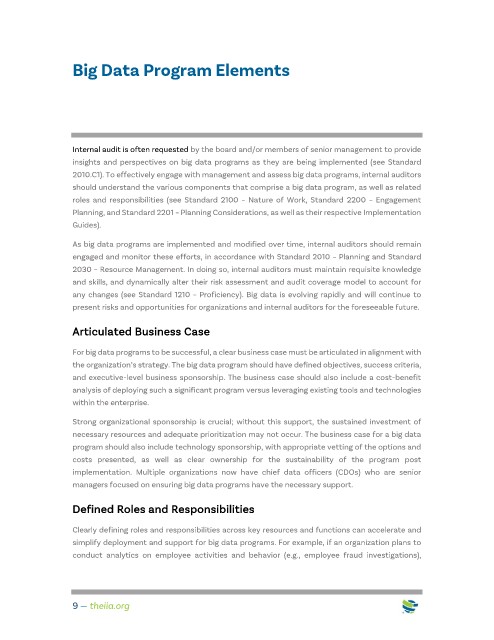Page 428 - ITGC_Audit Guides
P. 428
Big Data Program Elements
Internal audit is often requested by the board and/or members of senior management to provide
insights and perspectives on big data programs as they are being implemented (see Standard
2010.C1). To effectively engage with management and assess big data programs, internal auditors
should understand the various components that comprise a big data program, as well as related
roles and responsibilities (see Standard 2100 – Nature of Work, Standard 2200 – Engagement
Planning, and Standard 2201 – Planning Considerations, as well as their respective Implementation
Guides).
As big data programs are implemented and modified over time, internal auditors should remain
engaged and monitor these efforts, in accordance with Standard 2010 – Planning and Standard
2030 – Resource Management. In doing so, internal auditors must maintain requisite knowledge
and skills, and dynamically alter their risk assessment and audit coverage model to account for
any changes (see Standard 1210 – Proficiency). Big data is evolving rapidly and will continue to
present risks and opportunities for organizations and internal auditors for the foreseeable future.
Articulated Business Case
For big data programs to be successful, a clear business case must be articulated in alignment with
the organization’s strategy. The big data program should have defined objectives, success criteria,
and executive-level business sponsorship. The business case should also include a cost-benefit
analysis of deploying such a significant program versus leveraging existing tools and technologies
within the enterprise.
Strong organizational sponsorship is crucial; without this support, the sustained investment of
necessary resources and adequate prioritization may not occur. The business case for a big data
program should also include technology sponsorship, with appropriate vetting of the options and
costs presented, as well as clear ownership for the sustainability of the program post
implementation. Multiple organizations now have chief data officers (CDOs) who are senior
managers focused on ensuring big data programs have the necessary support.
Defined Roles and Responsibilities
Clearly defining roles and responsibilities across key resources and functions can accelerate and
simplify deployment and support for big data programs. For example, if an organization plans to
conduct analytics on employee activities and behavior (e.g., employee fraud investigations),
9 — theiia.org

